Remote and hybrid work have permanently changed how teams communicate. Email and phone alone can’t keep distributed teams aligned across time zones, tools, and customer touchpoints.
According to Nextiva’s Leader’s Guide to CX Trends, 81% of companies say customer experience improves when communication data is unified in one system, not scattered across disconnected tools. Choosing the right business communication platform today focuses on keeping teams and customers on the same page.
Finding a platform that supports business communication isn’t easy. No one tool is right for every team, although some cover most needs. From asynchronous messaging to video conferencing and remote capabilities, the list of tools can seem endless. We’ll help you find the best business communication tools that enable distributed teams to collaborate.
What Are Business Communication Tools? Why Are They Important?
Business communication tools are software and platforms that teams use to share information, manage projects, and stay connected. Examples include chat apps, screen sharing, video calls, email, and project boards like Jira. Teams use them to exchange updates, coordinate tasks, and maintain relationships between offices or remote setups.
Business communication software covers both everyday conversations and more structured work. A direct message in a chat app replaces a trip to a colleague’s desk. A project board tracks progress without the need for long status meetings. Video meetings enable face-to-face conversations when an email would be too formal.
Here’s how business communication tools fit into everyday work:
- Formats: Chat, email, video, file sharing (Dropbox, OneDrive), and project management platforms.
- Synchronous vs. asynchronous: Some work in real time (video calls, screen sharing, live chat), while others support delayed responses (emails, task boards).
- Scalability: Suitable for both small teams and large businesses spread across time zones.
- Integration: Connect to other apps like Microsoft 365 or Google Calendar, reducing the need to switch between platforms.
- Impact on company culture: Strengthen collaboration and keep teams motivated, even when not in the same workspace.

The right mix of business communication tools gives everyone a central place to share, plan, and collaborate. For some businesses, this means a central platform with integrated features. For others, it’s a small selection of well-connected apps. In either case, communication tools determine how work gets done and how teams stay aligned.
79% of CX leaders say their executive teams view customer experience—and the communication systems behind it—as a revenue driver, not a cost center.
—Nextiva CX Trends Report
Challenges Business Communication Tools Solve
Good communication keeps work moving, but many teams encounter the same obstacles. Without the right tools, small problems can escalate into larger ones that slow everyone involved down.
Information silos
Important knowledge gets stuck in long email threads or is confined to a few people, making it difficult for others to access it when needed. Breaking down these silos requires shared platforms where updates, files, and conversations remain accessible to everyone, whether they’re stored on the intranet, shared via Dropbox, or managed via real-time team collaboration boards.
Disconnected remote teams
Employees miss the quick, spontaneous conversations that happen in the office. A remote work culture can make teams feel isolated or out of sync. Remote work tools that support quick updates, informal chats, and AI-powered features like smart notifications restore this sense of connection.
Meeting fatigue
Too many video calls drain focus and waste time, especially when the discussion could instead take place in a chat or shared documents. A balance of different communication modes encourages strong collaboration without cluttering calendars.
Inconsistent customer experience
Nextiva’s Customer Patience Benchmark found that 28% of customers stop using a product or service after slow or poor support experiences.
When teams don’t share the same information, customers may receive different answers depending on who they speak with. Unified communications platforms provide all employees with the same context, so customers receive clear answers.
Business communication tools overcome these barriers, enabling shared information storage, real-time connection when needed, and reducing unnecessary meetings. They also create a consistent experience for everyone — from employees to customers.
Types of Business Communication Software
Below are some of the most common examples of business communication tools you’ll come across:
- Email: Essential for formal communication, document transmission, and information sharing. Platforms like Gmail and Outlook are popular choices.
- Instant messaging: Platforms like Slack, Microsoft Teams, and Google Chat facilitate real-time communication, quick updates, and team collaboration.
- Video conferencing: Tools like Nextiva, Zoom, Google Meet, and Microsoft Teams support face-to-face interaction for meetings, presentations, and remote collaboration.
- Project management software: Asana, Trello, and Monday.com help organize tasks, track progress, and manage projects effectively.
- Cloud storage: Services such as Dropbox, Google Drive, and Microsoft OneDrive enable teams to share and store files securely.
- Intranet: An internal website that provides employees with access to company information, resources, and communication channels.
- Social media: Platforms like LinkedIn and Facebook can be used for marketing, customer engagement, and building brand awareness.
- Business phone systems: Traditional phone lines, VoIP, and mobile phones are essential for voice communication. Nextiva is a popular VoIP phone service.
- Customer relationship management (CRM) systems: Tools like Salesforce or HubSpot help manage customer interactions and data.
- Collaboration platforms: Miro and Mural facilitate visual collaboration, brainstorming, and design thinking.
Best Business Communication Tools and Their Functions
Here are some of the best communication tools on the market, each with a use case that shows how they work in real-world scenarios.
1) Nextiva
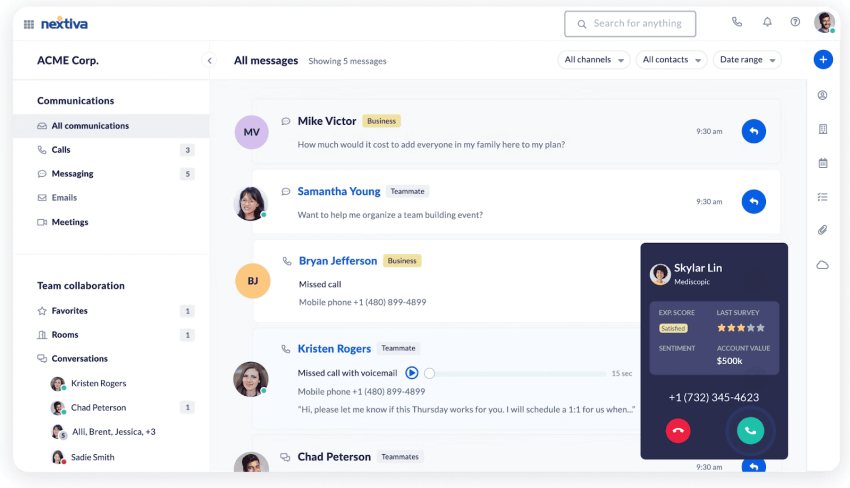
Best for: Businesses looking for a unified communications platform with strong VoIP and customer experience management capabilities.
Nextiva is the leading UCaaS platform that combines a business phone system, video conferencing, team chat, SMS, and customer management tools into a single, intuitive application. The unified user interface breaks down information silos and effectively connects internal teams with customers. Nextiva unifies multiple channels on a single platform, helping businesses save time, personalize customer support, make faster decisions, and avoid costly miscommunications.
Example use cases:
- A growing e-commerce business can use Nextiva to manage all customer interactions.
- The sales team can make calls from their business number while on the go.
- The support team can use the call center features to better handle customer inquiries via phone and chat.
- All employees can collaborate in team channels, relying less on internal email and creating a searchable knowledge base.
Notable features:
- All-in-one business communication (VoIP phone, team messaging, video chat, and more)
- Customer relationship management
- Desktop and mobile apps (iOS and Android)
- AI workflow automation and advanced analytics
- Social media and reputation management tools
- Contact center solutions and advanced call routing
Pricing plans:
- Core: Starting at $15 per user per month, this plan includes inbound and outbound calling, business SMS, video conferencing, and team chat.
- Engage: Starting at $25 per user per month, this plan also offers SMS messaging between customers and teams, a toll-free number, advanced reporting, and speech analytics.
- Power Suite CX: Starting at $75 per user per month, this plan offers omnichannel engagement, process automation, real-time dashboards, and AI-powered transcription.
Customer rating: 4.5 out of 5 (3,000+ G2 reviews)
2) Slack
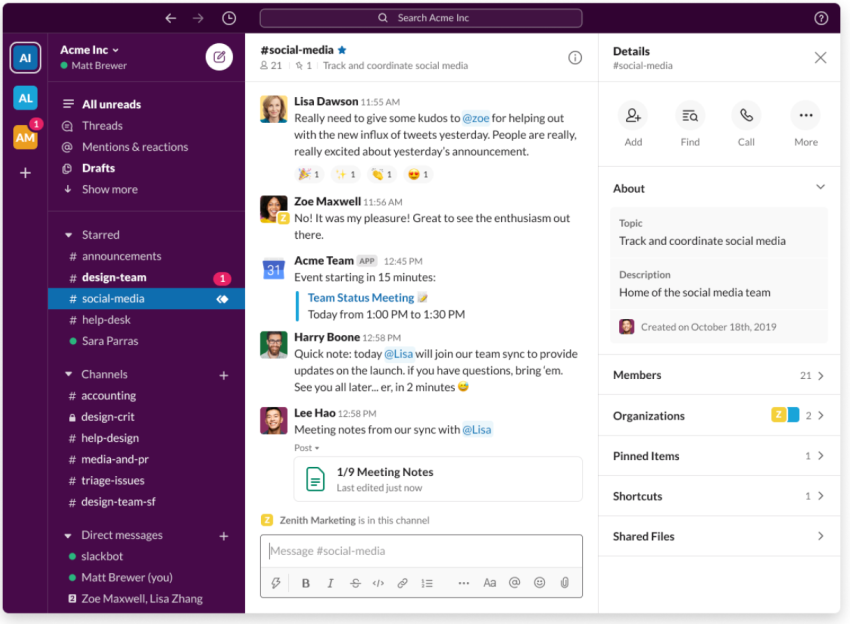
Best for: Teams that need a powerful and organized way to communicate and collaborate in real-time, especially in a remote or hybrid work environment.
Slack, one of the leading team messaging platforms, is replacing email as the primary communication channel for corporate teams. It streamlines employee communication and file sharing, making it easier to share information. Slack’s user-friendly interface simplifies managing multiple conversations and maintaining control over all communication channels, helping teams stay organized and on the same page.
Example use cases:
A marketing team can create a Slack channel for each campaign they’re working on. These channels can be used to share files, gather feedback, and make decisions quickly. They can also integrate project management and social media tools to receive notifications and updates directly in Slack, keeping everyone in the loop.
Notable features:
- Business text messaging with file-sharing capabilities
- Searchable conversation channels
- Straightforward integration with popular productivity apps and tools
- Easy invitations for external team members or guests
Pricing:
- Free: Limited to 90 days of message history and 10 integrations.
- Pro: Starting at $4.38/user/month (billed annually) with unlimited message history, unlimited integrations, and group video calls.
- Business+: Starting at $9/user/month (billed annually) with advanced security, AI conversation summaries, and compliance features.
- Enterprise+: Custom offering with enterprise-grade AI.
Customer rating: 4.5 out of 5 (35,000+ G2 reviews)
3) Notion
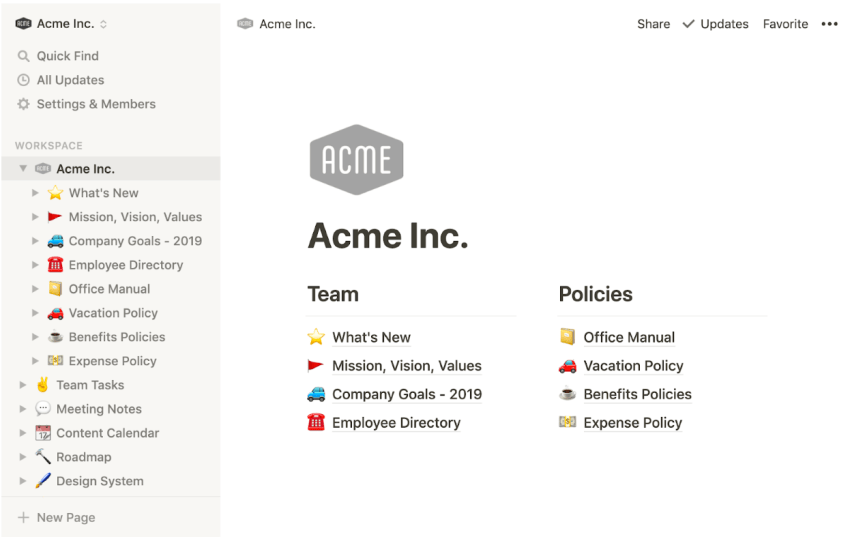
Best for: Teams and individuals who want a highly customizable all-in-one workspace for notes, project management, and knowledge sharing.
Notion is an all-in-one workspace that combines note-taking, project management, databases, image galleries, and calendars into a simple and intuitive platform. Start from scratch and customize the platform to your business needs, or use Notion’s professional template library for a solid start. This adaptability makes Notion a popular choice for small business owners seeking a cost-effective yet customized tool with a wide range of applications.
Example use cases:
A product development team can use Notion to create a roadmap for its new feature. It can use a database to track tasks, a calendar to set deadlines, and documents to create specifications. Also, create a knowledge base to store all research and user feedback in one place.
Notable features:
- Comprehensive note-taking and documentation app
- Fully customizable task management and databases
- Project management with calendar and timeline views
- Sharing and collaboration tools
Pricing:
- Free: For individuals, with a block limit of 1,000 for teams.
- Plus: Starting at $10/member/month (billed annually) for small teams with unlimited collaborative blocks and file uploads.
- Business: Starting at $20/member/month (billed annually) with advanced security and admin controls.
- Enterprise: Custom offering for businesses that need more scalability, control, and security.
Customer rating: 4.6 out of 5 (7,000+ G2 reviews)
4) Asana
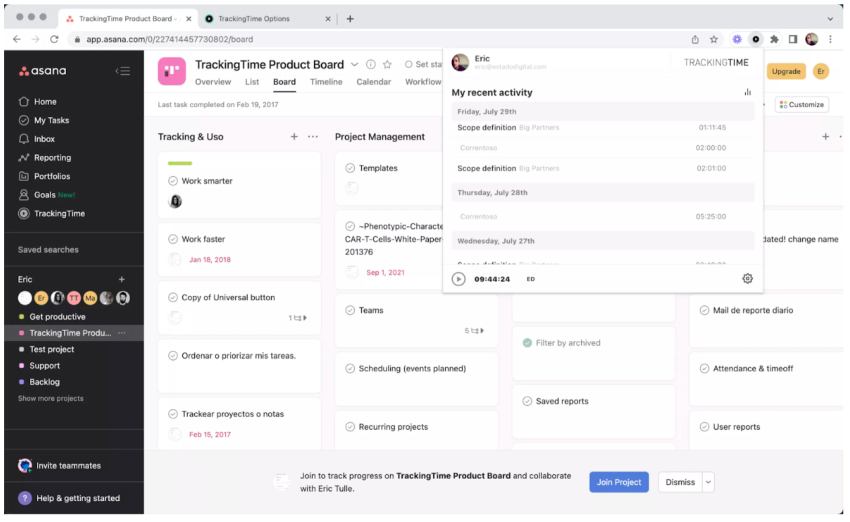
Best for: Teams that need a project management tool to organize, track, and manage their work from start to finish.
As a leader in project management, Asana is known for its intuitive user interface, advanced workflow and automation features, and resource management capabilities. With Asana, teams can manage all their projects, goals, and responsibilities across departments and deliver high-quality work.
Example use cases:
An event planning team can use Asana to manage all the tasks associated with organizing a conference. They can create a project for the event, then define tasks for each phase, such as booking a venue, finding speakers, and promoting the event. They can also assign tasks to team members, set deadlines, and track progress to keep everything on schedule.
Notable features:
- Comprehensive project management and workforce management tool
- Customizable project views (e.g., Kanban boards) and permissions
- Popular app integrations (e.g., Miro whiteboard integration)
- Project templates and dashboards
Pricing:
- Personal: Free for individuals and small teams of up to 10 teammates.
- Starter: Starting at $10.99/user/month (billed annually) with project schedules and unlimited dashboards.
- Advanced: Starting at $24.99/user/month (billed annually) with features like portfolios and goals.
- Enterprise: Tailor-made offering for large companies that need to coordinate and automate complex work across departments without restrictions.
Customer rating: 4.4 out of 5 (12,000+ G2 reviews)
5) Zoho One
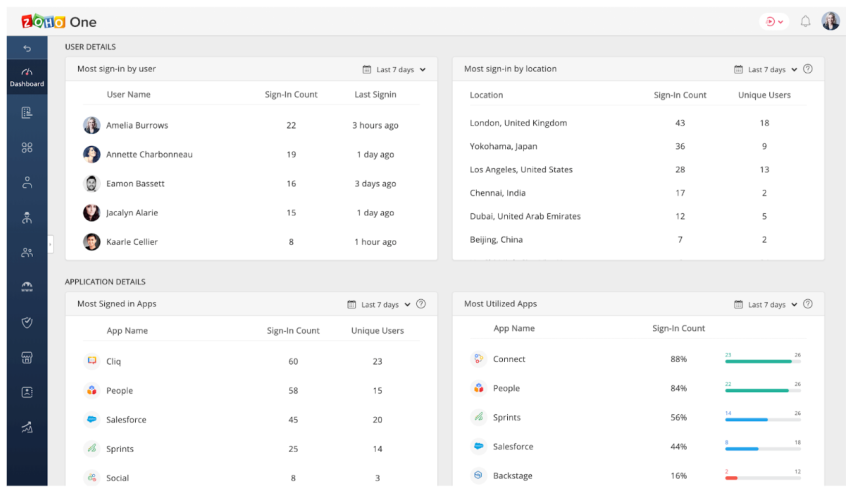
Best for: Businesses that want a suite of applications to run their entire operation, from sales and marketing to finance and HR.
Zoho One, often referred to as a business operating system, integrates applications for sales, marketing, support, accounting, operations, and human resources into a single platform. With over 45 applications to choose from, entrepreneurs can fully customize the platform to their needs. Zoho breaks down departmental boundaries and increases operational efficiency.
Example use cases:
Small businesses can use Zoho One to manage all aspects of their operations. They can use Zoho CRM to manage their sales pipeline, Zoho Books for accounting, and Zoho Desk for customer support. This business communication platform offers a complete overview of their business to make more informed decisions.
Notable features:
- All-in-one platform providing more than 45+ CRM, sales, and marketing tools
- Collaboration features and productivity functionality
- Finance and HR management tools
- Customizable and scalable tool
Pricing:
- Price for all employees: $37/employee/month (billed annually), requires licensing for all employees.
- Flexible user pricing: $90/user/month (billed annually), for businesses that only want to license a specific number of users.
Customer rating: 4.4 out of 5 (22,000+ G2 reviews)
6) Loom

Best for: Teams that want to communicate more effectively and personally with video messages, more in a remote or asynchronous work environment.
Loom enables you to easily record and share interactive videos with teammates and clients. It helps teams solve problems, provide feedback, and increase productivity. The asynchronous nature of video sharing and the human connection improve focus, clarity, and connection in distributed teams.
Example use cases:
A designer can use Loom to record a video of their screen to present a new design to a client. They can walk the client through the design, explain their choices, and gather feedback. This is more effective than sending a static image and trying to explain everything in an email.
Notable features:
- Easy-to-use dual-screen video recording and sharing
- Transcription and closed captioning capabilities
- Interactive viewer reactions and insights
- Straightforward integration with popular productivity tools
Pricing:
- Starter: Free plan with a limit of 25 videos per person and a recording time of 5 minutes.
- Business: Starting at $15/user/month (billed annually) with unlimited video and recording time.
- Business + AI: Starting at $20/user/month (billed annually) and includes AI-powered features such as silence removal and automatic summaries.
Customer rating: 4.7 out of 5 (2,000+ G2 Reviews)
Best Business Communication Tools for Startups
Startups face a unique set of communication challenges that differ from established businesses. Between rapid team growth, distributed workforces, and pressure to move fast with limited resources, choosing the right communication stack can make or break early momentum.
The tools covered above work well for many businesses, but startups need solutions that prioritize flexibility, speed of setup, and room to grow without breaking the bank or requiring dedicated IT resources.
Startup communication challenges in 2026
Early-stage companies encounter several communication obstacles:
Rapid scaling without the infrastructure. When you go from 5 to 25 employees in 6 months, communication that worked informally breaks down quickly. You need systems that scale without requiring major overhauls.
Distributed teams from day one. Many startups launch remote-first or hybrid, meaning employees may never share an office. This eliminates the casual hallway conversations and quick desk drop-bys that naturally keep teams aligned.
Tool fatigue and fragmentation. 86% of companies with multiple CX tools report siloed customer data, slowing and making communication less consistent across teams. Startups often add new software to solve immediate problems without considering long-term integration, creating tech sprawl that slows everyone down.
Budget constraints. Early-stage companies can’t afford enterprise contracts or pay per seat for tools most of the team won’t use. Every dollar spent on communication tools is a dollar not spent on product development or customer acquisition.
What startups should look for
Before committing to a communication platform, consider these priorities:
- Scalability that fits your budget. Look for tools with tiered pricing that let you start small and add features as you grow. Avoid platforms that force you into expensive enterprise plans before you’re ready.
- Minimal setup and training. You don’t have time for week-long implementations or extensive training programs. The best startup tools offer intuitive interfaces that new team members can use productively within minutes.
- Strong integrations. 68% of technology leaders are planning to consolidate their vendor count in 2026. Choose tools that connect seamlessly with your CRM, project management, and other systems to prevent data silos that slow down decision-making.
- Both real-time and asynchronous options. Distributed startup teams work across time zones. Your platform should support live video calls when needed while also enabling recorded updates and threaded conversations that people can access on their schedule.
Top Startup-Friendly Communication Platforms
Here’s how popular tools stack up for early-stage companies:
Slack
Best for: Tech startups prioritizing speed and informal collaboration
Slack’s channel-based messaging keeps conversations organized and searchable. With 6,000+ app integrations, it connects to virtually every tool in your stack.
Startup advantage: Free tier supports unlimited users with limited message history. Easy to upgrade as you grow.
Microsoft Teams
Best for: Startups selling to enterprise clients or heavily using Microsoft 365
Teams offers deep integration with the Microsoft ecosystem, combining chat, video, and file collaboration.
Startup advantage: Free plan includes unlimited chat history and 60-minute meeting limit — perfect for early-stage teams.
Zoom
Best for: Remote-first startups relying on video for collaboration and sales
Zoom provides reliable video quality across devices with screen sharing, recording, and whiteboard features.
Startup advantage: Familiar interface that customers and clients already know reduces friction for external meetings.
Google Workspace
Best for: Lean teams wanting multiple tools under one subscription
Workspace combines Gmail, Drive, Docs, Meet, and Chat into a unified suite.
Startup advantage: Affordable pricing and tools most people already understand mean minimal training time.
Asana
Best for: Startups managing multiple projects simultaneously
When integrated with Slack or Teams, Asana creates a system for project-based communication that prevents updates from getting lost.
Startup advantage: Clear task ownership and visual progress tracking keep small teams aligned without constant status meetings.
Why Nextiva Works for Startups
While specialized tools solve specific problems, many startups find themselves managing multiple platforms: Slack for internal chat, Zoom for meetings, a separate phone system for customer calls, and another tool for SMS. This creates the fragmentation startups are trying to avoid.
Nextiva combines voice, video, SMS, chat, and email in one unified platform. Your team manages all communication from a single interface, whether collaborating internally or engaging with customers.
Key advantages for startups
- Grows with your team: Nextiva supports over 100,000 businesses and 1 million users. Start with basic calling and messaging, then add AI-powered analytics and automated workflows as you scale.
- Eliminates data silos: 81% of companies say unified systems improve customer experience. When all communication lives in one platform, your team has complete context for every customer interaction.
- No IT team required: Built for non-tech founders with intuitive interfaces and 24/7 support. New team members can start taking calls and managing messages within minutes.
- Transparent pricing: Clear pricing tiers with no hidden fees make it easy to budget as you grow.
- All communication centralized: Voice calls, text messages, video meetings, and team chat are logged and searchable in one place, creating an invaluable record that would otherwise be scattered across multiple platforms.
For startups focused on both internal collaboration and customer experience, Nextiva offers a compelling alternative to managing multiple point solutions.
How To Choose the Best Communication Tool for Your Business
While you could use different tools, it’s always helpful to narrow down the choices and select the ones that best fit your business needs. Here’s what to look for when choosing your next business communication solution:
✔️ Is cloud-based and has a fast setup
A cloud-based tool enables easy access from anywhere, making it ideal for distributed and global companies to communicate and share files through cloud storage.
Choosing a tool that requires minimal configuration and integrates into your existing infrastructure prevents downtime and allows your team to get started quickly.
✔️ Offers a blend of asynchronous and real-time communication functions
Your communication platform of choice should feature a mix of asynchronous (e.g., email and team messaging) and real-time communication features (e.g., video conferencing tools and instant messaging apps). This blend caters to different work styles and project needs while ensuring flexibility in how your team communicates, especially in hybrid work models.
Asynchronous communication is meant to minimize distractions and notifications, allowing the recipient to work uninterrupted.
With virtual meetings declining in popularity, teams crave more asynchronous work formats. 62% of consumers say it now takes longer to get prompt customer service than in previous years, increasing the need for flexible, asynchronous communication channels that don’t rely solely on meetings or live calls.
Additional advantages of asynchronous work include its ability to minimize burnout, boost team confidence, and enhance productivity. What’s more, companies that excel at asynchronous work can use related data to boost their AI-driven efficiencies.
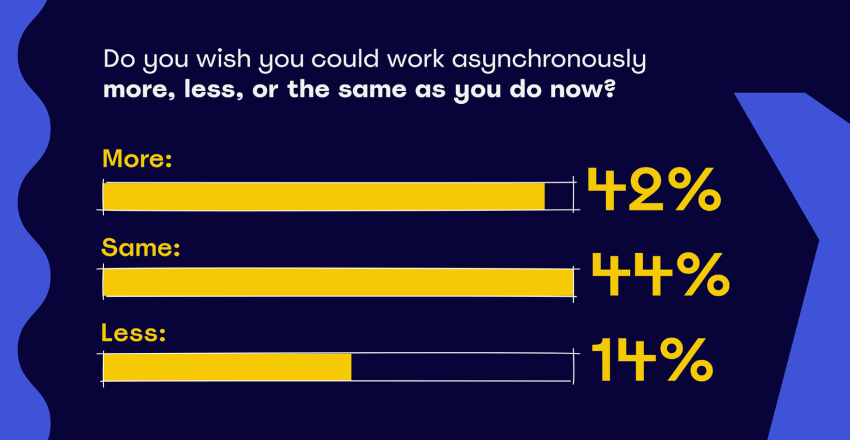
✔️ Solves practical business needs
Consider the practical nature of each tool and focus on its essential features as they relate to your team’s specific needs rather than being distracted by additional bells and whistles. Sure, new AI functionality may sound cutting-edge and cool, but is it worth the switch if the features you use most lack the functionality you need?
Whether you’re managing projects, brainstorming ideas, or conducting online meetings, each tool should enhance these tasks, not complicate them.
✔️ Integrates with existing apps
If you’re an established business, you likely already have a few team communication tools that you don’t want to part with. Ensure that any new platform offers easy integrations with the apps and tools your business already uses.
Just take it from the peer-to-peer software review site G2: integrations significantly reduce the time spent on juggling separate tools and increase productivity. Nextiva easily integrates with popular tools such as Zoho, Salesforce, HubSpot, Zendesk, Microsoft Outlook, Google Workspace, Microsoft Teams, and Oracle Sales Cloud.

✔️ Offers mobile and desktop apps
These days, a lot of teams can work from anywhere. Choosing tools that are as mobile as your team will power productivity in a way that feels right for team members. Mobile and desktop apps ensure they can stay connected and productive from their homes, in the coffee shop, or at a work site. Bridging the gaps between home, office, and on-the-go workspaces is as important as ever.
✔️ Has flexible pricing plans
The right tools offer pricing options that can scale with your business. Look for flexible pricing plans that provide basic features in the lower tiers while providing more advanced functionality for large teams. As your business grows, avoid the hassle of switching to another new tool. Select one that can adapt and meet your evolving needs from the start.
The Current State of Business Communication
Based on a study by Project.co, team communication currently looks like this:
- 31% use email.
- 30% use team messaging tools such as Slack.
- 15% use project management tools.
- 7% communicate by phone.
- 7% communicate face-to-face.
Many companies have permanently adopted remote work; however, this setting introduces additional communication obstacles, including wasted time, missed messages, burnout, missing files, bad customer experience, and customer attrition.
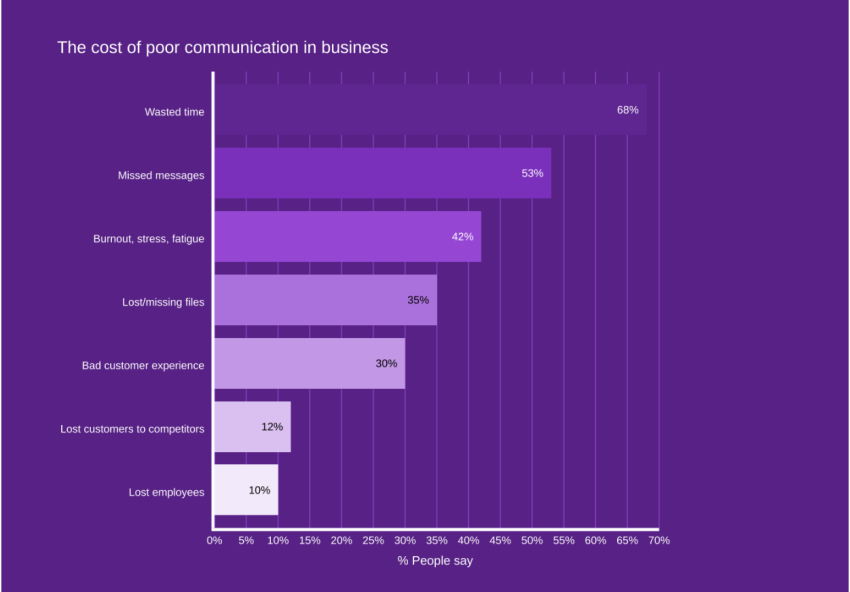
If you’re a business owner grappling with communication management challenges in a remote setting, you’re not alone. Over 70% of businesses have adopted new tools in the past year to help organize, communicate, and manage projects.
In 2024, businesses are moving toward adopting unified communication tools that reduce uncertainty, improve decision-making, and fully support the needs of remote teams. These tools integrate AI, asynchronous communication, and varied business channels, offering a reliable, effective, and engaging way to enhance workforce communications.
Unify Your Tools, Unify Your Team With Nextiva
In the past year, customer and market demands have increased, and what we expect from a communications platform is far beyond what we envisioned even a decade ago.
Communication tools are the linchpin to supercharging teamwork and scaling business productivity.
The right tools can provide clarity, enhance decision-making, and fully support the new hybrid remote work model. Looking ahead, AI is set to play an even greater role in revolutionizing external and internal communications, offering smarter, more intuitive, and increasingly automated ways to connect and collaborate.
Each of the tools discussed — Nextiva, Slack, Notion, Asana, Zoho One, and Loom — offers unique features. These platforms are at the forefront of enhancing business communication and will only become more efficient, predictive, and personalized as AI advances.
As you explore the best options for your business communication strategy, it’s essential to select the right tools. Nextiva stands out as a unified, cloud-based platform that addresses the communication needs of small businesses and adapts as your team grows.
Business Communication Tools FAQs
The four basic communication tools are:
1. Email: For formal communication, sending documents, and sharing information.
2. Instant messaging: For real-time communication, quick updates, and team collaboration.
3. Video conferencing: For face-to-face interaction for meetings, presentations, and remote collaboration.
4. Project management software: For organizing tasks, tracking progress, and managing projects effectively.
Small businesses and startups thrive with external and internal communication tools that are affordable, easy to use, and scalable. Opting for workplace communication software that combines several communication channels, such as phone calls, video conferencing, team messaging, and social media management, into one platform complements the dynamic nature of fast-moving startups. Tools such as Slack, Zoom, Nextiva, and Asana help teams succeed in remote, hybrid, or in-office work environments. When choosing a tool, consider your startup’s industry, team size, and communication needs.
Enterprises require robust communication tools that maintain high security and privacy standards. Enterprise communication tools should also integrate easily into their existing IT infrastructure. Popular choices for enterprises include Microsoft Teams, Cisco Webex, and Nextiva.
Yes. Several tools offer free versions suited for small teams. Slack provides messaging and file sharing on its free plan, Zoom allows video calls with time limits, and Microsoft Teams has a free version with chat and basic storage. Google Chat and Meet are also free with a Gmail account. While these options have restrictions, they work well until a growing team needs more features.
Here’s a list of “The Best Free Software for Small Businesses in 2026“.
Employees often depend on a mix of tools to stay connected and productive. Slack or Microsoft Teams handle daily messaging, while Zoom and Google Meet work for meetings and check-ins. Project tools like Trello or Asana keep tasks organized, and file-sharing platforms such as Google Drive support collaboration. The best tools are easy to use and fit naturally into everyday workflows.

















 Business Communication
Business Communication 











